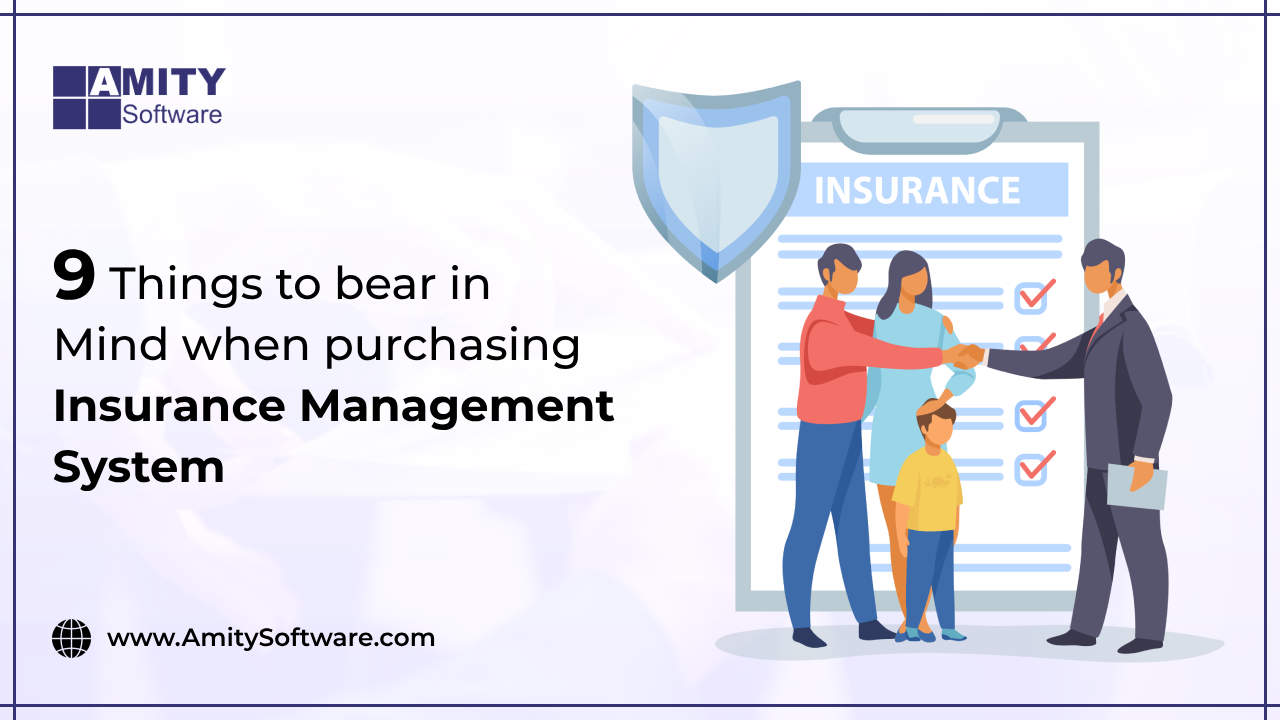9 Things to bear in Mind when purchasing Insurance Management System

In today’s rapidly evolving industry landscape, insurance sector might not be the quickest one to jump on digital transformation bandwagon, but sooner it realized that efficiency and accuracy are more crucial than ever. With a market that is expected to reach a valuation of $7 trillion by 2025, insurance providers find themselves in a precarious situation to widen their operations and enhance customer experience at the same time. To remain relevant and competitive in this dynamic landscape, vetting on the right Insurance Management System (IMS) is a necessity more than a choice.
But with the market these days flooded with so many systems, how do you choose the right one? Prior making a decision, there are 9 critical factors every insurance provider should consider. By the end of this blog, you’ll come to terms with the factors to when buying an IMS for your business.
Why should you even invest in the Insurance Management System?
In this highly competitive industry, beset with volatility in customer expectations and insurance workflows, an effective IMS can act as a game-changer in several ways. These systems are designed to automate and emulate insurance operations, otherwise manual, spanning over policy administration, underwriting, customer service and claims management through standalone software modules. Here’s why investing in a quality IMS is quite an essential deal.
- Increased Productivity and Workflow Efficacy-: An IMS is poised to automate highly repetitive and routine tasks such as manual data entry and claim processing, which significantly cuts down on administrative costs and time. Also, it streamlines workflows that channel the resources more towards strategic insurance activities than performing monotonous tasks.
- Enhanced Customer Experience-: In a market where customer loyalty is hard to achieve, an IMS allows faster response time, personalized service and achieving better communication with policyholders leading to higher retention rates and customer satisfaction.
- Data–Driven Decision Making-: With an IMS, insurers could leverage data analytics to gain valuable insights into consumer behavior, policyholders’ demography, market trends, and operational performance. This data-driven approach could be seen as a viable approach of staying ahead of the competition in the ever-changing insurance market.
Factors to consider when buying an Insurance Management System
Identifying Organizational Setting
When selecting an Insurance Management System, the first critical factor to consider is scalability. The term scalability refers to the ability of the insurance system to adapt to the changing requirements of the insurance business. However, before evaluating the IMS scalability an insurance provider should identify its organizational structure and one’s unique workflow to tailor the IMS effectively as per the business-specific requirements.
You can choose between On-premise or Cloud-based IMS based on the complexity of your insurance business among other factors. For instance, insurance companies having complex IT infrastructure demand a greater degree of customization and control which could be met through on-premise setup. Contrary to this, if you are a small or mid-scale insurance provider with limited resources then cloud-based IMS would attract lesser upfront costs as compared to its counterpart. It works better for businesses facing demand fluctuations on frequent occasions.
Vendor Stability and Financial health
The financial stability and health of an IMS vendor are two most relevant yet overlooked factors crucial for the long-term success. A financial unstable vendor may not be able to provide a handholding experience to implement ongoing support, update patches and even stay ahead of the competition. When assessing a vendor, consider the following things:
- Recent Investments in R&D: A vendor that has been vigorously investing on the front of innovation and development would seemingly come up with cutting-edge solutions, ensuring that your IMS remains competitive.
- Breakdown of Vendor’s financial health-: Review the vendor’s financial reports to stay attuned with their performance through key KPI metrics of liquidity and profitability.
Reviewing Financing Options
Different vendors of IMS often come up with varied financing options, which hold a significant forbearing on your financial planning. Consider the following financing options as per your individual business plans-:
- Purchase Vs Subscription-: Few vendors roll out one-time fee associated to the software implementation, while others offer subscription-based pricing. The subscription model has lower upfront costs but may end up in a higher aggregate cost over time.
- Leasing options-: Some vendors provide software or hardware services on lease, spreading out the cost, making it easier to manage your cash flows.
Evaluating Total Cost of Ownership
The initial purchase of an IMS is merely the tip of an iceberg, in reality the Total Cost of Ownership (TCO) is the overall cost incurred over the entire lifetime, including:
- Implementation Costs: This includes the expenses related to deploying the system, such as hardware, software licenses, and consulting fees.
- Maintenance and Support: Ongoing costs for software updates, technical support, and system maintenance.
- Training Costs: Expenses associated with training staff to effectively use the system.
- Customization and Upgrades: Additional costs for tailoring the system to meet your specific business needs and keeping it up-to-date with industry changes.
Estimation of the ROI
Return on Investment measure the value derived from the implementation of an IMS as compared to the costs incurred. An effective IMS helps in streamlining operations, reducing manual work, mitigating claim errors and subsequently leading to the reduced costs. However, computation of ROI requires a comprehensive understanding of the following attributes:
- Reduction in Errors and Claims Processing Time: A good IMS can significantly reduce the time taken to process claims and reduce errors, leading to faster payouts and improved customer satisfaction.
- Improved Regulatory Compliance: Avoiding fines and penalties through better compliance management can also contribute to ROI.
Striking a balance between Customizability and Cost
While the word customization may seem endearing to many insurance providers, but it acts like a double-edged sword that would lead to additional cost associated with those features. Hence, insurance providers should weigh the potential benefits of the customizable features over the financial implications it would bring along. Achieve this, by asking yourself the below question:
- Is the customization essential for your operations, or can off-the-shelf features would serve the purpose?
- What are the long-term costs associated with maintaining these customizations?
Integration Capabilities
The discussion so far only covered the factors corresponding to general attributes of an IMS; whereas to say relevant to the insurance business providers should also consider advanced capabilities in the recent modules of IMS. In short, an IMS must integrate with other essential systems used by an insurance company, such as:
- CRM Systems: These systems play a pivotal role in ensuring a unified view of customer interactions and data. Integrating CRM with IMS would help insurance companies in offering targeted demographics.
- Accounting Software: For streamlined financial management and reporting.
- Legacy Systems: The IMS should be able to integrate with or allow migration of data from older systems without disrupting operations.
Advanced Reporting Functionality
Data serves as a key entity to remain aware of your insurance firm’s performance. In majority of the traditional IMS, they usually combine the analytics and reporting capability within the CRM/ERP systems only. However, an advanced IMS should support data-driven decision making by offering real-time analytics and reporting capabilities. This can lead to improvement in the following areas:
- Improved Customer Insights: Understanding customer behavior through data analysis can lead to more targeted marketing and cross-selling opportunities, driving revenue growth.
- Enhanced Financial Forecasting: Accurate data allows for better financial forecasting, enabling more informed strategic decisions.
Optimizing Data Migration Process
- Data Migration: Consider the process of migrating data from your existing systems to the new IMS. Evaluate the vendor’s data migration tools and support to ensure a smooth transition.
- Transition Planning: A well-defined transition plan is essential to minimize disruptions. This includes planning for data transfer, user training, and system testing.
Purchasing an Insurance Management system is a complex procedure that requires careful consideration of several factors. Hopefully, now you feel familiar with the key considerations to keep in mind while making a purchase decision of an Insurance Management System. Given the vast challenges that insurance companies are grappling with, making a wise choice for the implementation of a dedicated IMS sets the stage for other insurance operations to fall in place.
To help you better understand these considerations, the blog performed a comprehensive breakdown of the factors that make an IMS suitable in the contemporary insurance landscape. This includes evaluation of the financial and the technical attributes that are a must to have in the IMS.
At Amity, we understand that whether it is revamping your existing insurance business infrastructure or starting from scratch it can be overwhelming at times. With Amity Assure, an integrated Insurance Management Software, you can easily migrate your existing workflows according to your business requirement. Hence, drop in a query for a detailed roadmap on how to determine the right insurance software for your company.












